
9381
.pdf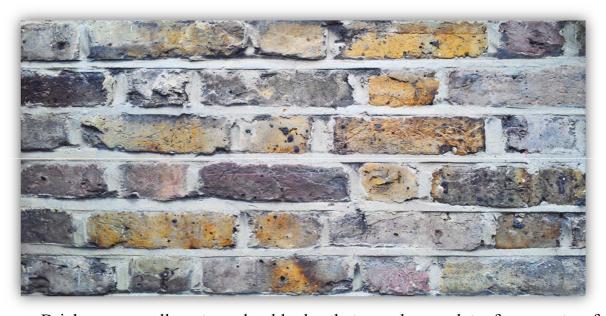
BRICK AND MASONRY
Bricks are small rectangular blocks that can be used to form parts of buildings, typically walls. The use of bricks dates back to before 7,000 BC, when the earliest bricks were formed from hand-moulded mud and dried in the sun. During the Industrial Revolution, mass-produced bricks became a common alternative to stone, which could be more expensive, less predictable and more difficult to handle.
Bricks are still in common use today for the construction of walls and paving and for more complex features such as columns, arches, fireplaces and chimneys. They remain popular because they are relatively small and easy to handle, can be extremely strong in compression, are durable and low maintenance, they can be built up into complex shapes and can be visually attractive.
However, more recently, other materials have been developed that can be used as alternatives for building walls or for cladding facades and for some building types, particularly larger buildings, bricks can be seen as time consuming, expensive (although this is disputed by the Brick Development Association), structurally limiting, and requiring too much on-site labour. Some of these difficulties have been overcome by the introduction of reinforcement systems and by the development of pre-fabricated brick panels.
In the UK, standard bricks are 215 mm long × 102.5 mm wide × 65 mm high. This gives a ratio of 3:2:1.
Bricks are most typically made from clay, although they are also commonly made from calcium-silicate and concrete.
Soft mud or dry-press bricks are formed by pressing the brick mixture into moulds and then firing them in a kiln. Soft-mud bricks are made from a thin mix whereas dry-press bricks are made from a thicker mix that gives crisper defini-
20
tion. Greater strength is achieved by using greater force when pressing the brick and by firing it for longer, but this increases the cost.
Extruded bricks are formed by pushing the brick mixture through a die to create an extrusion that is then wire cut to produce bricks of the required length.
Bricks can be solid, or can have holes perforated through them to reduce the amount of material used. Alternatively they may have an indentation on one surface (or two surfaces) commonly called a ‘frog’. The frog must be filled with mortar when bricks are laid otherwise the structural and acoustic performance of the wall will be affected. For this reason it is best practice to lay bricks with the frog facing upwards so that it is easy to fill. Where there are two frogs, the larger frog should face upwards.
Other than the standard rectangular block, a number of special shapes exist for particular circumstances that may be encountered when building with bricks. Engineering bricks have particularly high strength, low water absorption and good acid resistance. They are generally used for civil engineering applications.
Masonry is generally used to form the walls and other solid elements of buildings and structures such as bridges, tunnels and so on. It may be load bearing, forming an integral part of the structure, or non-load bearing, such as a partition wall or cladding.
Generally the size of the units is suitable for being laid by one person, although, increasingly, masonry is delivered to site in prefabricated panels that are craned into position. Masonry is often formed by laying a number of interlocking units, bound together by mortar, however, dry set masonry relies on the friction between the units to prevent movement, and does not require mortar.
Masonry is very strong in compression, but less effective at resisting lateral loading or tension forces. Additional strength can be achieved by increasing the thickness of the masonry, by the addition of piers or buttresses, or by the incorporation of reinforcement.
Masonry walls may have complex constructions to optimise performance, that may include hollow sections in the masonry itself, a cavity between internal and external leaves of the wall, insulation, a vapour barrier and internal and external finishes and decoration.
However, generally masonry does not require finishing and decorating and is very durable, so is relatively inexpensive to maintain and repair. It tends to offer good thermal mass, high acoustic insulation and good resistance to fire.
Masonry tends to be heavy, and so requires strong foundations. It can be prone to frost damage, staining and disintegration of joints.
21
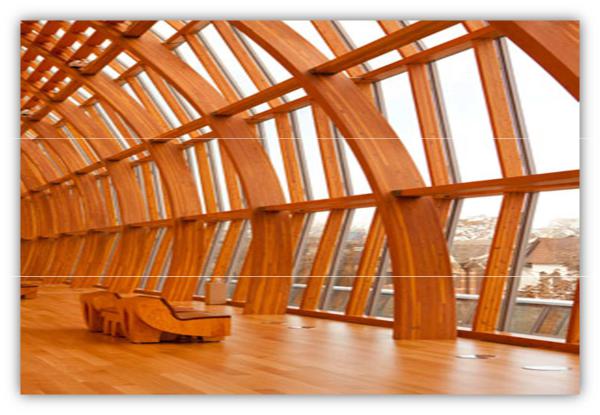
WOOD
Wood has been used in construction for thousands of years and is still one of the most widely used building materials. Certain properties of wood can be complex in terms of use for construction, but despite this, engineers have successfully harnessed this natural resource to build a variety of structures. From houses to boats and other shelters, as well as furniture and décor, the construction industry has exploited the potential of wood to the fullest.
Wood is favoured as a material because of the wide variety of properties depending on type. It is readily available and economically competitive, as well as being extremely strong in relation to its weight.
Wood is generally classified as hardwood and softwood. Hardwood is typically heavier and denser than softwood and is usually utilised for construction of walls, ceilings and floors. The highest possible grade of hardwood contains 83% usable material on one face and is suitable for high-quality furnishings, solid wood mouldings and interior joinery.
Softwoods are generally used to make more of the inner structures to the frame of hardwoods, such as doors and window frames. It is also used to produce furniture.
22
The words ‘lumber’ and ‘timber’ are often used to refer to wood used specifically in construction work, however there is debate as to which terms should apply to different scenarios. As a rule of thumb, wood which is smaller than five inches wide by five inches thick is referred to as lumber. These pieces are usually machine-planed and sawn for certain dimensions primarily being used in residential construction.
Pieces of wood over the lumber dimensions, regardless of length are timber, although any timber pieces that are more than eight inches wide and eight inches thick are called beams. As timber is usually larger in dimension it is used for the frames of structures in buildings and bridges, as well as being used in railroad ties, mine shaft support and crossbeams on utility poles.
Wood is 'renewable' when responsibly sourced. It is durable, reusable and recyclable. Some other benefits include: Thermal insulation. Acoustic insulation. Adaptability. Health benefits due its subjective comfort. Structural stability. Easy of manufacturing. Strengthens rural development and industry. Better fire resistance due to low thermal conductivity.
There are some disadvantages of wood but they are easy to disregard, and eliminate as long as the cause is known.
Wood is a hygroscopic material. This means that it will adsorb surrounding condensable vapors and loses moisture to air below the fiber saturation point.
Woods are organic goods. Like any organic good, wood is a nutritional product for some plants and animals. Insects drill holes and drive lines into wood.
Coating provides protection to wood used both indoors and outdoors. Coating prevents rapid uptake and loss of moisture and reduces shrinking and swelling that can lead to surface cracking and other problems. But coating does not totally prevent changes in moisture content. Coating slows, but does not halts moisture level.
Another disadvantage of wood is that it easily catches fire. Wood consists of organic compounds which are composed mainly of carbon and hydrogen. They can combine with oxygen and burns. Because of these properties, wood is classified as a combustible material.
It is impossible to make wood noncombustible like inorganic materials. In order to prevent potential dangers, wood can be processed in some fire retardants.
23
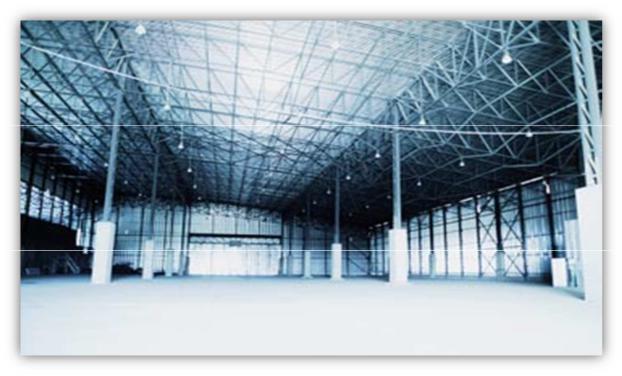
STEEL
Steel is one of the basic materials used in today’s civil engineering industry due to its proven high strength and durability.
Though commercial carbon steels do not corrode in pure, dry air at room temperature, they do corrode in moist and contaminated environments. Corrosion of steel used in buildings causes structural failures that result in safety hazards. The relatively newly emerged stainless steels, which contain a high proportion of alloy elements such as chromium, generally do not form rust on their surfaces and do not discolour at normal atmosphere.
As stainless steel possesses similar desirable properties to normal steel and eliminates their disadvantages, stainless steel has been widely used as a construction material. The rate of growth of stainless steel use in the civil engineering sector is rapid. It was estimated that in 2006, approximately 14% of the world’s total stainless steel production went into the construction industry.
The use of iron in human history can be traced to around 4,000 years BC when early civilizations in Asia and Africa used iron ore to make tools for agricultural purposes. In about 1400 BC, people learned to strengthen iron by heating iron ore and charcoal in simple furnaces.
Britain started to manufacture large amounts of iron in the early 15th century. During the 15th century, improvements of furnaces accelerated the development of the iron industry in England; between the 16th and 18th centuries, the lack of charcoal in England gave rise to a large amount of iron import from Sweden, America and Russia. Europeans used iron for roofing members in the 18th century.
24
The industrial revolution in the 19th century led to rapid development of the steel industry as the demand for machinery and transportation increased.
The mass manufacture and use of steel in the 20th century brought great advance to urbanization; from street lights to telephones, from typewriter to railways, the world benefited greatly from steel.
The most remarkable application of steel was the construction of the skyscraper which led the architectural world to a new era. Steel frames became commonly used from 1909 as their strength was proven. Though there were many attempts to develop iron alloys from the mid-19th century, applicable stainless steel was not developed until the first decade of 20th century.
Today, stainless steel is used extensively in roofing, cables of suspension bridges and flood barriers.
Stainless steel is iron alloys containing a minimum of approximately 11% chromium; this amount of chromium prevents corrosion in unpolluted atmosphere and this is the reason that the steel is named 'stainless'. As its name suggests, the corrosion resistance is one of the most important factors.
A few physical properties are important to stainless steels used for engineering purpose; specific gravity, electrical conductivity, magnetic susceptibility and thermal conductivity
Fracture toughness of a material is the resistance to fracture when small defects raise the stress locally to the breaking stress.
When a metal fractures under repeated stress at a level much lower than the ultimate tensile stress, it is called failure by fatigue.
There are over 200 kinds of stainless steel composition and there are new ones being developed each year. Each stainless steel can be distinguished by its response under heat treatment and the mode of fabrication.
Though stainless steel is known for its high corrosion resistance, corrosion can still occur.
Stainless steel is well-known for its ductility and thus is considered less likely to fail during earthquakes than other building materials such as concrete.
Recycling of stainless steel is economically important as it contains valuable alloy elements.
Today many buildings are renewed by over-cladding and over-roofing, where a new cover is installed over the existing one to improve energy efficiency, fix damage and enhance appearance. Stainless steel can be used as overcladding roofing panels and brackets for connecting the old and new structures.
25
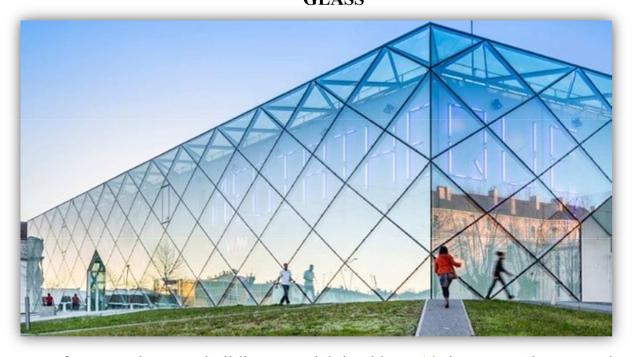
GLASS
If we use glass as a building material, it adds on 10 times more beauty and elegance to the look and feel of the building. Glass is a brilliant material which has various properties and uses, and it presents architects with various new designs and possibilities. It is mostly used as a transparent glazing material in construction and is also used in architectural features like windows, doors, and partitions in the office area.
A glass is basically a transparent hard substance that is created by the application of heat to sand. It is an inorganic, transparent or translucent material and can be easily molded into any shape with the help of high-temperature heat. A glass is a mixture of raw materials like sodium potassium carbonate, lime, Silica, and Manganese oxide.
Glass as a building material is the most versatile and oldest material trusted by architects to be used in the construction of a commercial glass building. And its role in architecture has evolved over the years. Traditionally, the glasses were defined as the supercooled liquids. And this is because the glasses do not behave like metals or plastics on cooling.
Archaeological evidence has been found of man-made glass dating back to 4000 BC in the form of decorative glazes. In prehistoric times, weapons were made using naturally occurring glasses found in volcanic regions and after lightning strikes. Around 1500 BC glass was first used as a material for making hollow containers. The Romans excelled at glassmaking. When the Roman Empire fell, the skills spread throughout Europe and the Middle East.
Since that period, glass manufacturing techniques have developed considerably with advancements in science and technology.
26
Properties of Glass: 1. Strength
A glass is a hard material but it is liable to break easily. Thus, one should be careful while using glass as a building material and in the home as well.
2. U value
U value is the measurement that calculates the amount of heat transferred through the window. The lower the U- values of glass, the better the insulation properties.
3. Workability
A glass can be used in various ways as it can be blown drawn and pressed. Thus, it can be molded into different shapes and serves various purposes.
4. Transparency
A glass is transparent and allows visual connection with the outside world. Though, its transparency can be altered just by adding admixtures and can leave the overall beautiful look of glass.
5. Greenhouse effect
The trapping of heat in the glass leads to a higher temperature and the trapping occurs due to the greenhouse effect.
6. Recyclable
The glass material is totally recyclable and the broken glass scrap is gathered and remelted to be used again.
Most common types of glasses used for glass buildings are toughened glass, laminated glass, tinted glass, double glazed glass.
A glass has a great number of advantages. It can absorb, refracts and transmits 80% of available natural daylight in both the directions. A glass can be made transparent or translucent, thus it adds extraordinary beauty to the building. It can be blown, drawn and pressed to any shape and hence it is used for various purposes. It is dustproof and can be easily cleaned because of smooth and glossy texture. Glass does not rust so it does not degrade by time with chemicals and surroundings. A glass is 100% recyclable and it does not degrade during the process of recycling. The broken pieces of glass can be gathered and melted and it becomes reusable. It is unaffected by noise, air, water and most of the acids thus, it makes the building look beautiful lifelong.
However, a glass is unsafe for earthquake proven area. Use of glass in a building enhances the cost of security because of the transparency. The glass is made of very rigid and easily breakable material so when it is subjected to stress, it breaks without strain. Glass absorbs heat and acts as a greenhouse, hence are not suitable for hot climates. In spite of all these shortcomings, glass usage helps with environment-friendly office buildings. A glass is 100% recyclable and sustainable; using glass is a great way to conserve the natural resources. The best part about using a glass is it can be recycled numerous times and will still not lose its quality and strength.
27

3.Group work (expert group):
Each expert group member will return to their home group and will retell the summary of their type of building material.
4.Group work (home group):
Return to your home group and correct the tables with building materials features.
Discuss, find the advantages and disadvantages of different types of building materials
5.Group work
Make a cluster and present the most widely used building materials in your country.
TYPES OF BUILDING
MATERIALS
28
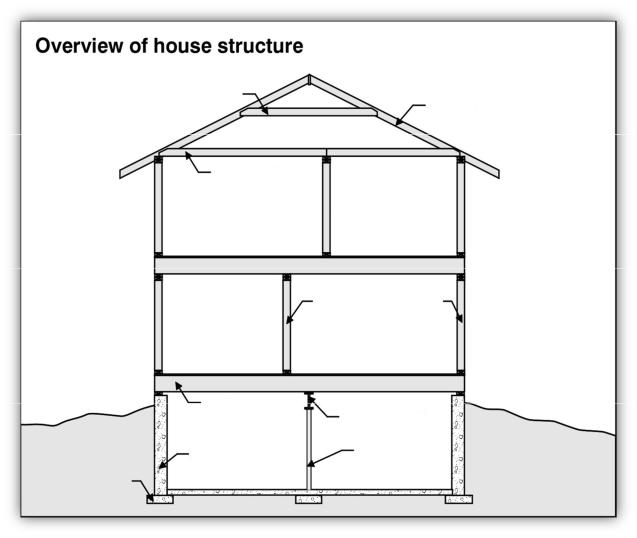
2.2.BUILDING ELEMENTS
Lead in
1. What is framework? What structural elements can you name?
2. Put the following elements of the house into the right place in the picture:
collar tie |
затяжка стропил |
roof rafter |
стропила крыши |
ceiling joist |
балка потолка |
bearing wall |
несущая стена |
exterior wall |
внешняя стена |
floor joist |
балка пола |
bearing beam |
несущая балка |
column |
колонна, стойка |
foundation wall |
фундаментная стена |
footing |
опора |
29
